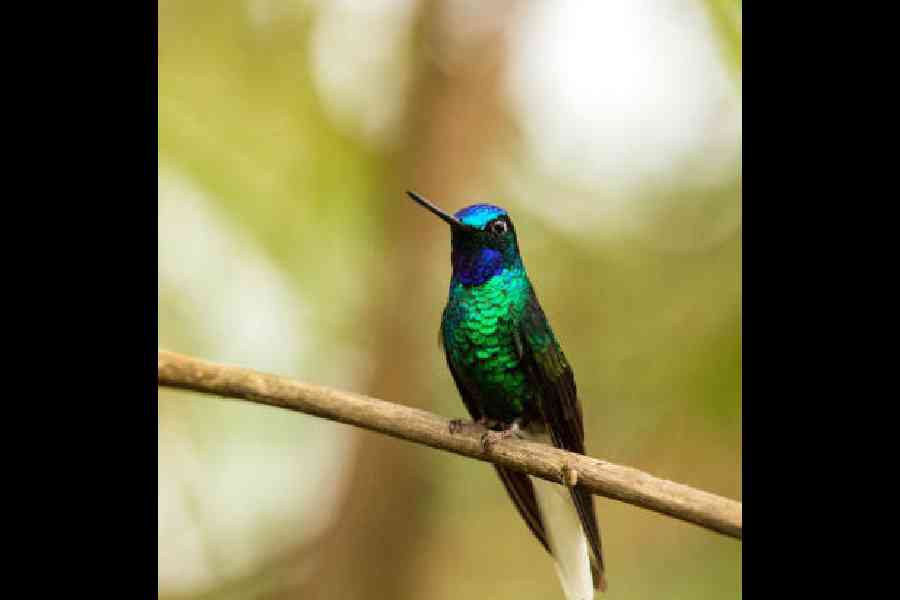In 2022, an ornithologist high in the Sierra Nevada de Santa Marta mountains of northern Colombia spotted the shimmering emerald green and cobalt blue feathers of the Santa Marta sabrewing. A large hummingbird, it had been documented only twice since 1879. As the bird sat on a branch, the ornithologist, Yurgen Vega, captured images.
The bird was on the American Bird Conservancy’s 10 most wanted list, which sits atop a longer register of “lost birds”, which are defined as not having been documented by photographic, audio or genetic evidence in a decade. A major goal of the list is to persuade bird-watchers to look for these birds when they go out into the field, and bring back evidence that the birds have not gone extinct.
People have searched for lost birds for decades. But the process was formalised in 2020 by the conservancy, in partnership with two other groups, Re:wild and BirdLife International, as the Search for Lost Birds project. Researchers published a paper recently with a definitive list of birds that need finding. They scoured millions of photos, videos and audio recordings in birding databases such as iNaturalist and xeno-canto. The study concluded there are 144 species of bird lost to the scientific world but that may still exist.
“Through more exposure in global ornithological and birding networks, there’s great potential to learn more about birds that are poorly known and highly threatened,” said Cameron Rutt, the lead author of the paper who coordinated the project for the American Bird Conservancy until recently.
Once the birds are documented, experts analyse how they can be protected and studied. Since the rediscovery of Santa Marta sabrewings (in pic), for instance, researchers have been studying the bird’s habitat needs and biology.
They have identified five small populations of the birds, about 50 individuals, in a small forested valley on one fork of the Guatapurí River in Colombia. The sabrewing population is a case of micro-endemism, experts say, a species restricted to one very small, specific place. It’s critically endangered.
Finding a species prompts a new list of challenges. What is the best way to protect it, whether from storms, a changing climate or crowds? Esteban Botero-Delgadillo, director of conservation science for SELVA, a Colombian conservation organisation, said he and others worried that “if this news came out there would be a lot of bird-watchers and people”.
Another recently found bird from the list is the black-naped pheasant pigeon. The chicken-size bird was found in a remote region of Papua New Guinea in 2022 after not having been documented in 126 years. To find the pheasant pigeon, the most endangered terrestrial bird in Papua New Guinea, researchers travelled to villages where the bird had last been seen.
Among those was John C. Mittermeier, founder of the Search for Lost Birds Project. “People who live there are largely subsistence farmers, fishermen and hunters and so they know the land and the wildlife really, really well,” he said. “We asked them whether they had seen this species,” whose local name is auwo. One day one of the birds strutted in front of a camera trap that had been set up.
“Seeing those first photos felt like finding a unicorn,” Mittermeier said. “It’s the moment you dream about your entire life as a conservationist and bird-watcher.”
Three species in North America are considered lost. Best known is the ivory billed woodpecker. Its last accepted sighting in the US was in Louisiana in 1944. It was spotted again in Cuba in 1987. There has not been a confirmed sighting since. Because of grainy videos of what could be the bird, the U.S. Fish and Wildlife Service has not declared the bird extinct.
The other two birds in North America are the Eskimo curlew and the Bachman’s warbler.
It hasn’t taken long for some of the project’s 144 lost birds to be found; more than a dozen have been located already. The first came before the paper was published: the mussau triller was photographed in Papua New Guinea by Joshua Bergmark, a tour guide with Ornis Birding Expeditions.
Mittermeier was elated.
NYTNS











